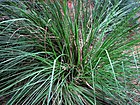Note: This is a project under development. The articles on this wiki are just being initiated and broadly incomplete. You can Help creating new pages.
Chrysopogon zizanioides - Vetiver
Vetiver is a perennial bunchgrass of the Poaceae family. It is native to India. In western and northern India it is popularly known as khus.
Contents
- 1 Uses
- 2 Parts Used
- 3 Chemical Composition
- 4 Common names
- 5 Properties
- 6 Habit
- 7 Identification
- 8 List of Ayurvedic medicine in which the herb is used
- 9 Where to get the saplings
- 10 Mode of Propagation
- 11 How to plant/cultivate
- 12 Commonly seen growing in areas
- 13 Photo Gallery
- 14 References
- 15 External Links
Uses
Nerve problems, Stress, Emotional traumas, Lice, Repelling insects, Insomnia, Muscle pain, Joint pain, Sore throats
Parts Used
Chemical Composition
Benzoic acid, the molecular formula is C6H5COOH, is a colorless crystalline solid and a simple aromatic carboxylic acid[1]
Common names
| Language | Common name |
|---|---|
| Kannada | Lavancha |
| Hindi | Balah |
| Malayalam | Ramaccham, Ramachehamver |
| Tamil | Lamichamver, Vattiver |
| Telugu | Ayurugaddiveru, Kuruveeru |
| Marathi | NA |
| Gujarathi | NA |
| Punjabi | NA |
| Kashmiri | NA |
| Sanskrit | Abhaya, Amrinata |
| English | Vetiver |
Properties
Reference: Dravya - Substance, Rasa - Taste, Guna - Qualities, Veerya - Potency, Vipaka - Post-digesion effect, Karma - Pharmacological activity, Prabhava - Therepeutics.
Dravya
Rasa
Tikta (Bitter), Kashaya (Astringent)
Guna
Laghu (Light), Ruksha (Dry), Tikshna (Sharp)
Veerya
Ushna (Hot)
Vipaka
Katu (Pungent)
Karma
Kapha, Vata
Prabhava
Habit
Identification
Leaf
| Kind | Shape | Feature |
|---|---|---|
| Simple | The thin leaves and stems are erect and rigid |
Flower
| Type | Size | Color and composition | Stamen | More information |
|---|---|---|---|---|
| Unisexual | 2-4cm long | Purple | 1 | The plant bears small brown-purple flowers in long spikes |
Fruit
| Type | Size | Mass | Appearance | Seeds | More information |
|---|---|---|---|---|---|
| 7–10 mm | Clearly grooved lengthwise, Lowest hooked hairs aligned towards crown | - | - | {{{6}}} |
Other features
List of Ayurvedic medicine in which the herb is used
Where to get the saplings
Mode of Propagation
How to plant/cultivate
Conical ridges, 30-38 cm high and 48 cm apart are made at the summit and the slips planted 23 cm apart on the summit.[4]
Commonly seen growing in areas
Tall grasslands, Meadows, Borders of forests and fields.
Photo Gallery
References
External Links
- Ayurvedic Herbs known to be helpful to treat Nerve problems
- Ayurvedic Herbs known to be helpful to treat Stress
- Ayurvedic Herbs known to be helpful to treat Emotional traumas
- Ayurvedic Herbs known to be helpful to treat Lice
- Ayurvedic Herbs known to be helpful to treat Repelling insects
- Ayurvedic Herbs known to be helpful to treat Insomnia
- Ayurvedic Herbs known to be helpful to treat Muscle pain
- Ayurvedic Herbs known to be helpful to treat Joint pain
- Ayurvedic Herbs known to be helpful to treat Sore throats
- Herbs with Leaves used in medicine
- Herbs with common name in Kannada
- Herbs with common name in Hindi
- Herbs with common name in Malayalam
- Herbs with common name in Tamil
- Herbs with common name in Telugu
- Herbs with common name in Sanskrit
- Herbs with common name in English
- Habit - Herb
- Index of Plants which can be propagated by Seeds
- Index of Plants which can be propagated by Cuttings
- Herbs that are commonly seen in the region of Tall grasslands
- Herbs that are commonly seen in the region of Meadows
- Herbs that are commonly seen in the region of Borders of forests and fields
- Herbs
- Poaceae





